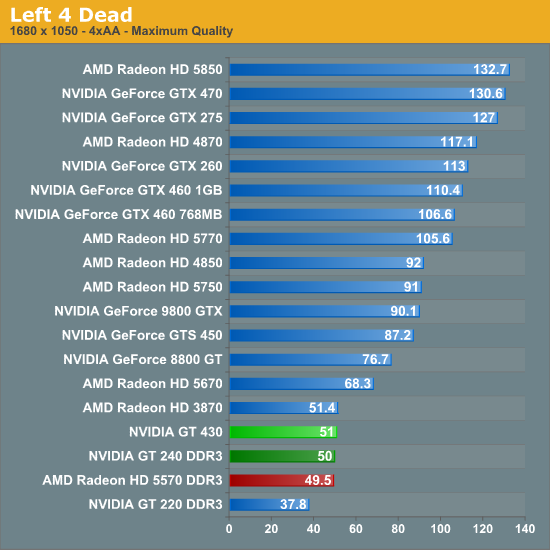NVIDIA's GeForce GT 430: The Next HTPC King?
by Ryan Smith & Ganesh T S on October 11, 2010 9:00 AM ESTLeft 4 Dead
Introduced in 2004, Valve’s Source engine continues to live on in new Valve games. At this point even newer Source games like Left 4 Dead are rarely GPU limited to a significant degree, but we keep it on here due to the fact that we’re expecting at least one more souped-up Source game next year’s in Portal 2.

L4D is actually the one game even our value cards can deal with at 1680, showcasing the lightweight nature of the Source engine. It’s also another game the GT 430 does fairly well at, edging out the 5570 and the GT 240. Of course it’s still well behind the 5670. Interestingly this is the only game we use anti-aliasing on where the GT 430 is playable. This is solid proof of the advances made for Fermi’s ROPs, as it’s doing as well as older NVIDIA cards with twice as many ROPs.










120 Comments
View All Comments
Ryan Smith - Monday, October 11, 2010 - link
None of the good product shots I have include passive GT 430s. However there are 2 in the collage on an NV slide: a Sparkle and a Zotac.ranger203 - Monday, October 11, 2010 - link
I have a Geforce G210 for my media center and it runs blu-rays well. I am looking for a little more umpppff to allow some post processing of other videos. But I paid $35 for my card, and the only way I would replace it was if this one was under $50.But.... a quick froogle search found they want to go for around $75. Giga-byte offers a passive cooler, looks pretty bad ass.
http://www.provantage.com/gigabyte-technology-gv-n...
Lolimaster - Monday, October 11, 2010 - link
Just buy a HD5550. You shoul've started buying an AMD IGP Mobo, that's enough.Nvidia on the low end is just worthless.
DMisner - Monday, October 11, 2010 - link
I noticed it has the same number of CUDA cores as the GT 240. Would this perform any better or about the same as the GT 240 for Folding@Home?AznBoi36 - Monday, October 11, 2010 - link
It's slower than the GT240. Also the GT240 is a full height card, while this one is low profile. There is a reason why this card is called the GT430 and not a GT440.mczak - Monday, October 11, 2010 - link
Hmm on page 1 it says roughly same die size as "Juniper GPU in the 5500/5600 families" - that should be redwood. Also, the "GT430 goes up against... GT430..." I guess that should be GT240?I'm really wondering how they attach 4 rops to two memory partitions btw. I believe that one quad rop per partition wouldn't really have required a lot of changes over one octo-rop per partition, but either the quad-rop block was split into 2 or it's actually attached to both MCs. Of course, for actual color fillrate, it doesn't really matter if there are 4 or 8 rops - pixel output is limited to 2 per SM anyway.
jsbiggs - Monday, October 11, 2010 - link
Additional correction:On the Power, Temperature, and Noise page, the line "Even at these low wattages where our 1200W power supply isn’t very efficiency". Probably should be "...isn't very efficient". Cheers.
Onferno - Monday, October 11, 2010 - link
Passively cooled and working as a PhysX card:http://www.hardwareheaven.com/reviews/1046/pg10/zo...
kmitty - Monday, October 11, 2010 - link
Depends on your definition of 'ultimate'. For me, just looking at it and seeing a fan meant it wasn't my ultimate HTPC card - absolute silence required!mcnabney - Tuesday, October 12, 2010 - link
No kidding.An ideal HTPC card is:
1. Silent
2. Consumes very little power
3. Can decode all current and pending video format/containers
4. Fits half-height as well
5. Has rock-solid driver support
6. Cheap
7. Bitstream audio and includes a full version of BluRay software to support it
This card just doesn't measure up. Ideally the best HTPC card isn't a card, but is actually part of the motherboard.